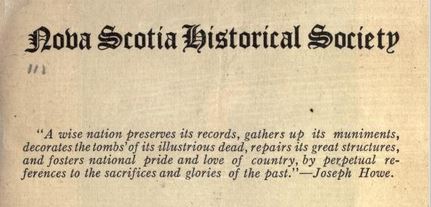|
JUDGE MORRIS' REMARKS CONCERNING THE REMOVAL OF THE ACADIANS [This paper was digested in July, 1755, at the period when the measure- was first proposed — probably before it was sanctioned in Council by the approbation of Boscawen and Mostyn. Mr. Morris' remarks concerning the removal of the French inhabitants, the difficulties to be apprehended, and the means of surmounting them.]
----Some reflections on the situation of the inhabitants, commonly called neutrals, and some methods proposed to prevent their escape out of the colony, in case upon being acquainted with the design of removing them, they should attempt to desert over to the French neighboring settlements, as their firm attachment to them may be conjectured to raise in them a strong effort, desire to attempt it. ----The greatest district and that which comprehends the most families is that of Minas, to whom belong the inhabitants of the Gaspero. In 1748 they were reported to be in number, upwards of 200 families, of which 180 families live at Minas, 30 on the Gaspero, and about 16 in two small villages on the River Habitants. These all dwell within in the compass of six miles, and occupy for their livelihood and subsistence these marshes which are situated on the Basin of Minas called Grand Pre, on the north of the River Habitants and on the River Gaspero. ----The River Canard settlement lies to the south west, and contains about 150 families, of whom 50 live on a point of land lying between the River Habitants and the River Canard ; 60 live on the west side of the river in a compact village about two miles from its mouth, and 25 more up the river along the banks on both sides(for the convenience of the marsh) to Penus Mills, which are near the road coming from Annapolis to Minas, and distant from Grand Pro nine miles from the mouth of the Canard to the River of the Neiux Habitants, are settled 10 families and 4 or 5 families more at the River Pero. All these inhabitants have by the river aforesaid a communication by water with the Basin of Minas, and some live contiguous to it. ----Pezaquid is a settlement south-easterly of Minas, they are scattered in many small villages, the principal of which are those settled on the River Pezaquid, above the confluence of the River St. Croix. On the River St. Croix these are situated between Fort Edward and the district of Minas and southerly towards the road to Halifax. A few small villages belonging to this district are to the east and northward of Fort Edward, and a few families at Cape Fondu — " Fondu " which makes the east head of the great river of Pezaquid. These have all communication by water with the Basin of Minas, and are, in the whole, upwards of 150 families. ----Cobequid, it is at present uncertain as to the number of inhabitants, as some have quitted that settlement and gone over to the North Shore, but the several settlements in 1748 were as follows — on the south side of Coopigate Basin — Petit Rivieie — 4 families; Nela Noel, 7 families ; there are west of the Suberaccada, upon the River Suberaccada, two small villages, one near the mouth on the west side, the other on the east side near the confluence of Sherwraick (Stewiack) River, 1 4 families ; east of the Suberaccada Villa Perce Burke, 8 families (in a later copy 10 families) ; Ville-Michael Oguin, 10 families. These are all the families south of the Basin in an extent of several leagues. On the north side of the Basin Ville Jean Doucet, 4 families ; behind Isle Gros., 4 families ; at Point Economie from thence to village Ville Jean Burke, 3 leagues east, where is 10 families ; another river 2 leagues, called Ville, 9 ; Burke, 12 families ; thence one league to Cove d'Eglise, where is 17 families ; ½ league further is the River Chaginois, where are 15 families by this river is one passage by which they go to to Tatamagouch, a port on the Gulf of St. Lawrence— distant from these houses 30 miles, 12 miles of which they go by water on the River Chaganois ; between this and the head of Copegate Basin, which is 2 leagues, dwell about 20 families more. The extent of these north settlements is near 12 leagues — all these have a communication with the Basin of Minas. To this district belonged two small settlements at Tatamagouch, 12 families; and 8 miles westward, at Ramshuk, 6 families. The whole number of families in Coopegate district, 142 families. ----The district of Annapolis contains about 200 families, they live on both sides of the river from Goat Island to the distance of 24 miles, according to the course of the river, in small villages, the biggest of which is Bell Isle, 10 miles above Annapolis, where are about 25 families ; all these inhabitants live near the banks of the river and have no settlements back. ----The passages by which they may desert the Colony, and the means of blocking them up. ----1st. The inhabitants of Annapolis have but two ways by water through the Gut of Annapolis to the North Shore — 2 by land. But if they attempt it by land they ntust first come to Canard, Minas or Pezaquid. One of the sloops in the government service with whale boats, anchored at the naouth of the Basin of Annapolis would effectually prevent their escape by water, and the road by land is almost, if not altogether, impracticable for families and cattle and effects. ----From the Basin of Minas they must pass either thro' the Gut or pass over the River Chignecto on the other side of the Basin, near the Gut, where there is a communication by water by two rivers and a small carrying place into the Basin of Chignecto. ----Another vessel anchored in Cove Sabellist would prevent them going either out of the Gut or into the river — because they must pass near them, and could easily be prevented. The other passages by water must be into the Cobequid Basin to the river, can soon reinforce them with numbers sufficient to maintain their ground. ----This, therefore, will be the consequence unless timely removed, which can be effected only with a superior force to that which at present is in the colony, for the whole troops together do not exceed 1000 men, and they so separated through the difficulties attending the several parts of the Province, while these traitors are in it, that they cannot be collected and joined without having some or other parts exposed defenceless. ----That whilst it continues in this state the settlers will be obliged to confine themselves within their town lots and piquets, and thus rendered incapable of cultivating and improving their lands, and will be induced to seek, repair to the other lots where they may more easily obtain the necessaries of life, rather than bring them' selves and families to be thus inhumanly butchered. ======================================== Collections of the Nova Scotia Historical Society Publication date 1878 Comments are closed.
|
Archives
June 2025
Category
All
|


 RSS Feed
RSS Feed


